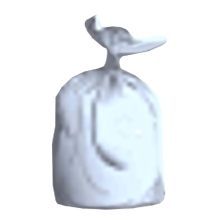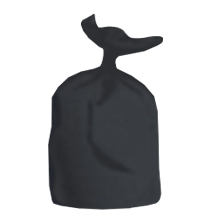The Guernsey environment is unique and is central to every aspect of life. Our coastal zone, boasting one of the largest tidal ranges in the world, has a range of sea life to be envied and protected. That same tidal zone along with the coastal fringe, rugged cliffs and natural flora and fauna provide Guernsey with a characteristic landscape worthy of international recognition. Guernsey's countryside with its narrow lanes, earth banks, douits, vernacular architecture and small hedgerow bordered fields (supported by the dairy farming of a prized breed) presents a mosaic of land parcels where individual species and small constrained habitats are key to the island's biodiversity.
Ramsar Sites
Guernsey's geographic location and its large tidal differences create and support a diverse range of habitats. The convergence of cold (boreal) and warm currents (Lusitanian) biogeographic regions support an array of species which include rich plankton currents, which flow eastward from the Atlantic to the North Sea. On 1st March, 2006, Guernsey designated its first Ramsar site. This site which measures 426 hectares encompasses Lihou Island, La Claire Mare Nature Reserve, and the Colin Best Nature Reserve, as well as the intertidal area and outlying reefs and rocks. On 19th October 2015, Herm, Jethou and the Humps were designated as the Bailiwick's second Ramsar site. Outline maps of both of these sites can be downloaded from this page and further information about each site is detailed below.
Designation of a wetland site under the Ramsar Convention elevates the status of the site to that of "International Importance", bringing special notice to the environmental, cultural and heritage aspects of the area. This recognition provides a positive focal point for new education, tourism and environmental initiatives which contribute to the long-term conservation and wise-use of that particular site and other wetland areas.
The Ramsar Convention on Wetlands of International Importance
- The Convention on Wetlands of International Importance was signed in Ramsar, Iran in 1971. Known as the Ramsar Convention, it aims to promote the conservation of wetlands and their resources through their "wise use". The concept of wise use is at the heart of the Convention. Wise use means making use of a wetland in a sustainable way so that it may yield the greatest continuous benefit to present generations whilst maintaining its potential to meet the needs of future generations. The official name of the treaty - The Convention on Wetlands of International Importance Especially as Waterfowl Habitat - reflects its original emphasis on the conservation and wise use of wetlands primarily to provide habitat for water birds. Over the years, the Convention has broadened its scope to cover all aspects of wetland conservation and wise use, recognising wetlands as ecosystems that are extremely important for biodiversity conservation in general and for the well-being of human communities.
What is a "Wetland"?
- The Ramsar Convention takes a broad approach in determining the wetlands which come under its auspices. Under the Convention, wetlands are defined as: "areas of marsh, fen, peatland or water, whether natural or artificial, permanent or temporary, with water that is static or flowing, fresh, brackish or salt, including areas of marine water the depth of which at low tide does not exceed six metres".
Why conserve wetlands?
- Water is the stuff of life! Wetlands are amongst the most productive of the world's ecosystems supporting a rich biodiversity. Wetlands are also a resource of great economic, cultural, scientific and recreational value. Unfortunately, wetlands continue to be amongst the world's most threatened ecosystems.
- Threats to wetlands include:
- - drainage projects
- - pollution
- - overfishing
- - over-exploitation of other natural resources (e.g. marine aggregates)
What is Guernsey committed to?
- The Ramsar Convention was extended to our shores in 1999. By signing up to the Convention, the States of Guernsey has made a commitment to the international community to ensure that our wetland areas, both freshwater and marine, are managed wisely. This means that the States of Guernsey is already, in fact, committed and complying with the conservation principles of the Ramsar Convention. Guernsey already has a good track record in this regard with, for example, its strict rules in relation to ormering and its reluctance to allow quiet natural bays to become beach resorts with all the associated development and activities.
- In addition, the Island is obliged to designate at least one wetland site that meets the Convention's Criteria for inclusion on the List of Wetlands of International Importance (The Ramsar List). Listed sites do not necessarily require protected area status, provided their ecological character is maintained through a wise use management approach.
What does designation mean for users?
- Right from the outset, it is important to stress that the designation of an area of the Island's shoreline as a Site of International Importance will not result in traditional activities such as shore gathering, inshore fishing, angling, sailing, diving, etc being prohibited. Ramsar's approach is quite the opposite of attempting to ban activities but rather seeks to ensure that the activities are conducted in a sustainable manner so as not to lead to a negative change in ecological character and so as not to prevent future generations from enjoying and utilising the wetland. Traditional practices which do not damage the long-term security of a habitat are not only allowed but are positively encouraged.
- Sites designated under the Convention do not have to be afforded any special/additional legal protection as a result of being designated. Instead, the approach is to promote conservation and wise use of wetlands by raising awareness within the local community through effective communication and education initiatives. Guernsey, of course, has limited resources with which to achieve such awareness raising and promotion of the designated site. It is important, therefore, that in taking forward the work towards designating a site, a firm focus is maintained on how resources can be best utilised to meet the Convention's requirements.
Why designate a Ramsar site?
- Designation of a wetland site under the Ramsar Convention elevates the status of the site to that of "International Importance". This recognition provides a positive focal point for new education, tourism and environmental initiatives which contribute to the long-term conservation and wise use of that particular site and other wetland areas. Designation of the Southeast coast of Jersey as a Ramsar site in November 2001 has provided a focus for education and eco-tourism. The site has been featured in many regional, national and international media publications and productions since it was added to the Ramsar List. However, perhaps more importantly, Islanders are now aware that an area of marine environment they have long known is special in their own local context, is also of major significance to the wider world.
- Alderney and Sark have also designated areas under the Ramsar Convention.
- Ramsar designation also provides Guernsey with the opportunity to acknowledge, on an international platform, our responsibilities for sound, forward-thinking environmental management of our most precious natural resources.
Lihou Island and L'Erée Headland
- The Island was purchased by the States of Guernsey in January 1995. The States of Guernsey Agriculture, Countryside and Land Management Service, who are responsible for managing the Island, is mindful of the sensitive balancing act between the needs of the visitor and the needs of wildlife. From a distance, Lihou Island looks like a low lump of rock emerging from the sea, with patches of grass growing on it. On closer inspection, it becomes clear that the island is a thriving community with a wealth of habitats. The island was recognised as part of a "Site of Nature Conservation Importance" (SNCI) as part of a 1989 study, and along with much of the Guernsey coastline it is designated an internationally "Important Bird Area".
- The bird nesting sites on Lissroy and Lihoumel are breeding areas for species such as Gulls, Cormorants and Oystercatchers. The public are asked to avoid these sites, which are clearly marked with signs and roped off areas. On the main island, various bird species can be found from the familiar and amiable Robin to the elusive and breathtaking Peregrine Falcon. As the tide goes down, exposing the rocks and shingle of the intertidal area around the causeway, it is often possible to spot waders such as Oystercatchers, Curlews, Turnstones and Redshank moving around the pools and shoreline looking for food. Little Egrets and Grey Herons can be seen fishing in pools and shallows, and Shags occasionally venture into the shallow water near to the causeway in search of a meal. The birds, particularly the Oystercatchers and Curlews, are often heard before they're seen, with the Curlews' distinctive "Courli" and the often frantic sounding "Kleep-kleep-kleep" of the Oystercatcher. In winter, Brent Geese may be seen feeding on the eel-grass in the channel.
- Dogs are not allowed on Lihou Island or the causeway in order to protect the birds there.
- A variety of seashore life lives around both the Lihou causeway and the rest of the shoreline, including Shore Crabs, Edible Crabs (Chancres), Porcelain Crabs, Velvet Swimming Crabs and Hermit Crabs scuttle from under rocks and into seaweed. Their close relations, Squat Lobsters, can be found lower down the shore, and Shrimps and Prawns thrive in the rockpools. Limpets, Winkles, Topshells, Dog Whelks and other members of the snail family can be seen alongside starfish. Anemones, such as the Beadlet and Snakelocks, lurk among the rocks. These same rocks provide a refuge for a wide variety of worms, including the Ragworm. Seaweeds, or algae, are abundant; over 200 species have been listed, five of which are not recorded for any other site in the Channel Islands.
- Flora (plant life) on Lihou Island is diverse and many of the pathways are carpeted by Buckshorn Plantain, whilst Wild Carrots, Violets, Cinquefoil, Trefoils and Campion are scattered in the areas of short turf. A number of very rare species such as Sand Crocus, Dwarf Pansy, Sand Quillwort and Early Meadow Grass have also been recorded.
- Lihou boasts an impressive collection of legends surrounding its obscure history. The ruined priory is thought to be the largest religious relic in the Bailiwick. The house was shelled during the German Occupation of the Channel Islands during World War II.
- The causeway which links Lihou Island to Guernsey at low tide is approximately a quarter of a mile long. The causeway opening times and important information must be consulted before crossing the causeway. Please note there are no public toilet facilities on Lihou Island, the closest public toilets are located at L'Erée Beach car park.
Herm, Jethou and the Humps
- The ecological character of Herm, Jethou and The Humps is a shallow marine ecosystem comprising a small archipelago of islands and rocky islets. Shorelines are rocky and sandy, with an extensive intertidal zone, rich in biodiversity.
- The site has an exceptionally large tidal range - at up to 10 metres, it is among the largest in the world and the intertidal zone is particularly large and biodiverse. Several important habitats are present, including Eelgrass (Zostera) beds, Maerl beds, shallow reef systems and seven sunken shipwreck reefs, which provide spawning grounds for fish such as Sea Bass and Black Sea Bream. The Ramsar site is contiguous with benthic and pelagic habitats, respectively supporting flatfish, shellfish; seabirds, Basking Shark, Sun Fish, Atlantic Grey Seal and four species of cetacean. The coastlines provide breeding sites for nine species of seabird and Atlantic Grey Seal.
- In terms of human geography, fishing (both commercial and recreational) within the site is of high cultural, economic and traditional importance to the population of Guernsey. There are significant archaeological and historical features and Herm Island is a tourist destination attracting in the region of 80,000 visitors each year.
- Herm Island is owned by the UK Crown, administered by the States of Guernsey and leased to the Herm Island Company Limited. Please visit their website for details of how to get to the island.
Other Environmental Sites
The States of Guernsey Agriculture, Countryside and Land Management Service (ACLMS) manages a number of important Environmental Sites on Guernsey. The Service works closely with other organisations, such as La Société Guernesiaise and the National Trust, who also manage their own Environmental Sites, to ensure a co-ordinated approach is adopted. Further information on some of the sites managed by ACLMS can be found below:
Bluebell Wood
- The Bluebell Wood, along with the whole of the east and south coast of Guernsey, has been designated as a Site of Nature Conservation Importance (SNCI), as it is the finest example of the type of woodland native to Guernsey. The woodland has the greatest floor covering of bluebells of any area within Guernsey and, as such, is an important area both for public enjoyment and for the protection of this species. A network of paths provides the public with a pleasant and sheltered walk through the woodland area.
- The woodland habitat, in general, functions as a food source for a whole host of wildlife species. For example, ivy provides berries for thrushes, the trees provide perching areas and food for tits and warblers.
- In order to retain a bluebell carpeted woodland it is important to maintain a high, shady tree canopy. Following hurricane-force winds in 1987 and the loss of trees to Dutch elm disease, the States initiated a tree planting programme to assist the regeneration of the site to protect the bluebells. The management of the area is reviewed regularly.
- The best time of year to see the bluebells is generally mid-April to mid-May, although the timing varies slightly each year according to weather conditions. The woods are located in the south east of the island within St Peter Port. On foot, the Bluebell Wood can be accessed from the cliff path network, and is located in between Soldier's Bay and Fermain Bay. Alternatively, there is a small car park at the Fort George Military Cemetery (Perry's Guide reference page 25, G4).
Bordeaux Nature Reserve
- The Bordeaux Nature Reserve is located along the north-east coast of Guernsey, approximately 1 kilometre north of St Sampson's Harbour (Perry's reference page 7, H5). The site covers an area of approximately 9 acres and comprises of an artificial hougue created by a completed landfill quarry. The site was quarried in the early 1900's and was subsequently used as landfill site between 1971 and 1992; topsoil and overburden tipping was completed in 1994.
- The management aims of this former landfill site are to enhance the character and landscape value by recreating its former wild, natural state; improve the site's importance for nature conservation and encourage the site's role as an area for informal recreation.
- There is plenty of car parking for visitors to the site.
Château des Marais
- The Château des Marais (also known as Ivy Castle) is situated to the north of St Peter Port and is accessed from Le Grand Bouet road or by footpath from Victoria Avenue. The area was listed as a Site of Nature Conservation Importance (SNCI) in 1989. The area comprises of a large wet meadow. The Château itself is situated on a small natural hougue, and is surrounded by a small moat. There is also a small field, an area of woodland which supports some tall Poplars and Common Sallow, a green field and a small reed bed.
- The Château des Marais is of nature conservation value largely due to the wet grassland habitat present in the large meadow, which contains a number of important species not found anywhere else on Guernsey, for example the Marsh Speedwell, as well as a number of species with restricted local distribution, such as the Greater Pond Sedge, Hard Rush and Strawberry Clover.
- Birds such as Robin, Dunnock, Blackbird and Stonechat make use of the site in a number of ways including nesting, feeding and roosting.
- The Château itself supports a range of habitats and the grassland in the centre is diverse both in plant and invertebrate species.
- The moat is a seasonal area of deeper freshwater, partly shaded by mature trees. The water supports a diverse plant and insect ecology in spite of its temporary nature.













